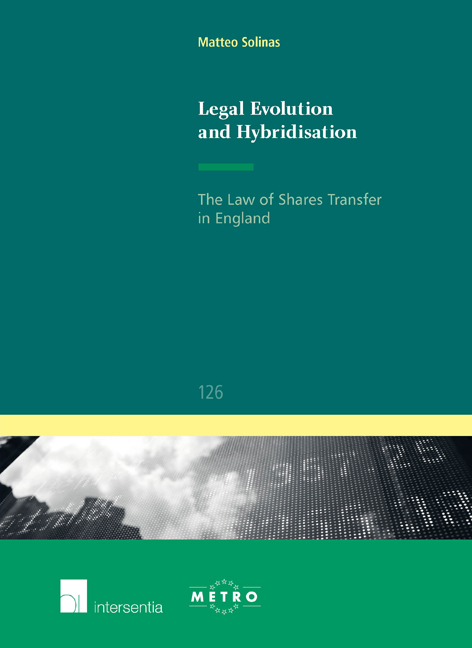Book contents
- Frontmatter
- Foreword
- Preface
- Acknowledgements
- Contents
- Table of Cases
- Introduction
- PART I THE IDEA OF HYBRIDITY IN COMPARATIVE LAW
- PART II THE CIRCULATION OF SHARES
- Introduction to Part II
- Chapter 4 The Transfer of Registered Shares
- Chapter 5 The Transfer of Share Warrants to Bearer
- Summary of Part II
- PART III THE TRANSFER OF (INTERESTS IN) SHARES
- Summary of Part III
- Conclusions
- Bibliography
- IUS COMMUNE EUROPAEUM
Chapter 5 - The Transfer of Share Warrants to Bearer
from PART II - THE CIRCULATION OF SHARES
Published online by Cambridge University Press: 22 November 2017
- Frontmatter
- Foreword
- Preface
- Acknowledgements
- Contents
- Table of Cases
- Introduction
- PART I THE IDEA OF HYBRIDITY IN COMPARATIVE LAW
- PART II THE CIRCULATION OF SHARES
- Introduction to Part II
- Chapter 4 The Transfer of Registered Shares
- Chapter 5 The Transfer of Share Warrants to Bearer
- Summary of Part II
- PART III THE TRANSFER OF (INTERESTS IN) SHARES
- Summary of Part III
- Conclusions
- Bibliography
- IUS COMMUNE EUROPAEUM
Summary
Registered shares and share warrants to bearer express the same economic function as units of the corporate capital. They differ in terms of their legal nature and modes of circulation. It has already been pointed out that this has an historical explanation.
Within the theoretical boundaries of this study, Chapter 5 investigates the historical evolution of the transfer of share warrants to bearer. It shows that some of the roots of the current legal characterisation can be found in certain Italian notarial exchange contracts used to obviate the risk of physical transport of money for long-distance trade in the Middle Ages. These instruments were received in English commercial practice in the fifteenth century and developed later on through a process of hybridisation.
This chapter is organised as follows. Section 1 establishes where the law related to share warrants to bearer currently stands. As was the case in Chapter 4 with respect to registered shares, the goal of this chapter is to offer a coherent overview of the subject matter before embarking on a historical discussion.
The fundamental finding in section 1 is that share warrants to bearer are negotiable instruments. Building on this, section 2 examines the origin and development of the concept of negotiability. It discusses the Italian contract of cambium and then deals with the gradual process of recognition of the alienability of rights in personam embodied in the documents in England.
Section 3 assesses the significance of market practice as the medium for exporting the Italian scheme for negotiable instruments and traces the history of the bills of exchange within the debate on the role of merchant law for the development of the common law. The arguments on the possible incorporation of the law merchant into common law by adapting old legal principles to new commercial necessities are tackled in some detail so as to show how legal growth has occurred via hybridisation. Section 3 also offers additional arguments for assessing the extent of borrowing and the pattern of legal change. In particular, it considers the precise position of the innocent purchaser for value of negotiable instruments, suggesting that the holder in due course doctrine has not been a key element of the law in that area from its earliest stages, but it has been a later indigenous achievement.
- Type
- Chapter
- Information
- Legal Evolution and Hybridisation , pp. 109 - 132Publisher: IntersentiaPrint publication year: 2014



